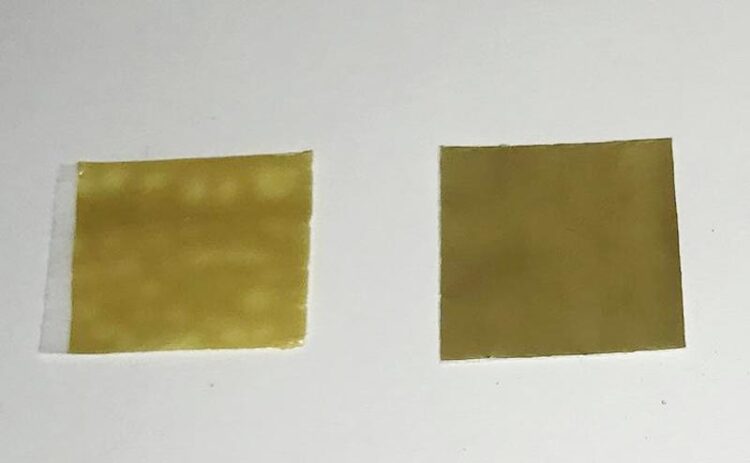Antibacterial material for use with internal medical devices

Membrane films containing MOFs, like those shown here, that produce nitric oxide could provide antibacterial properties in medical devices.
Credit: Colorado State University Department of Chemistry
… such as hip replacements or pacemakers.
Thin films containing metal-organic frameworks slowly release nitric oxide, an antimicrobial agent.
Researchers at Colorado State University and the University of St. Andrews in Scotland have developed an effective and flexible antimicrobial material that could be used to coat medical devices placed inside the body.
The work combines previous research from both universities into metal-organic frameworks – three-dimensional crystalline materials made of metals and linkers that are porous and remain stable in water. Working together, the teams combined their two frameworks into a single thin- film membrane to slowly release nitric oxide. A well-known antimicrobial agent that occurs naturally in the body, nitric oxide not only kills bacteria and fungus on contact but continues to do so over an extended period of time.
The study was published in the November issue of ACS Applied Materials & Interfaces.
Chemistry Professor Melissa Reynolds, who led the work at CSU, said that coating implanted devices with the material may provide a non-drug-based route to preventing infections in common surgical procedures such as hip replacements or shunts that are in constant contact with skin. About 1% of patients undergoing hip or knee replacements may develop an infection after the operation according to the American Academy of Orthopaedic Surgeons.
“Non-elective surgery is a key area for this work because they are increasingly common and many people getting them have underlying medical issues that increase the chances for infection. Additionally, many patients may not realize they have developed an infection from the surgery until much later,” she said. “Using this material could help keep those devices running smoothly inside the body and prevent the need for additional surgeries.”
Many medical devices currently use silver coatings to prevent infection. However, there is a potential for high doses of that element to leach into the body over time. Additionally, silver cannot be used for some types of implanted devices that are load-bearing or require support. Reynolds also noted that while drugs can treat infections, they have a limited life span of effectiveness and may bring side effects.
To develop the thin-film material, the team studied three membranes with different combinations of the metal-organic frameworks using a new cryogenic imaging technique. Reynolds said that helped the team identify the best ratios and methods to release the nitric oxide.
“The preliminary data shows the material is effective at eliminating common bacteria such as staph or E. coli,” she said. “We also found that a very small amount of this material by weight percentage is still very effective at killing bacteria. That is promising for future applications and for feasibility in use outside of a university test setting.”
Reynolds said the team will continue to research the delivery methods and how to take the material from its current thin-film form to something that can be applied across devices like pacemakers.
“Any implantable device is a candidate for this technology, and we think it will actually be inexpensive to manufacture,” she said. “We haven’t found any limitations yet and are looking forward to working with companies to develop this approach.”
Journal: ACS Applied Materials & Interfaces
DOI: 10.1021/acsami.3c11283
Article Title: Mixed Metal–Organic Framework Mixed-Matrix Membranes: Insights into Simultaneous Moisture-Triggered and Catalytic Delivery of Nitric Oxide using Cryo-scanning Electron Microscopy
Article Publication Date: 11-Oct-2023
COI Statement: The authors declare no competing financial interest.
All latest news from the category: Medical Engineering
The development of medical equipment, products and technical procedures is characterized by high research and development costs in a variety of fields related to the study of human medicine.
innovations-report provides informative and stimulating reports and articles on topics ranging from imaging processes, cell and tissue techniques, optical techniques, implants, orthopedic aids, clinical and medical office equipment, dialysis systems and x-ray/radiation monitoring devices to endoscopy, ultrasound, surgical techniques, and dental materials.
Newest articles

Compact LCOS Microdisplay with Fast CMOS Backplane
…for High-Speed Light Modulation. Researchers from the Fraunhofer Institute for Photonic Microsystems IPMS, in collaboration with HOLOEYE Photonics AG, have developed a compact LCOS microdisplay with high refresh rates that…

New perspectives for material detection
CRC MARIE enters third funding period: A major success for terahertz research: Scientists at the University of Duisburg-Essen and the Ruhr University Bochum have been researching mobile material detection since…

CD Laboratory at TU Graz Researches New Semiconductor Materials
Using energy- and resource-saving methods, a research team at the Institute of Inorganic Chemistry at TU Graz aims to produce high-quality doped silicon layers for the electronics and solar industries….



